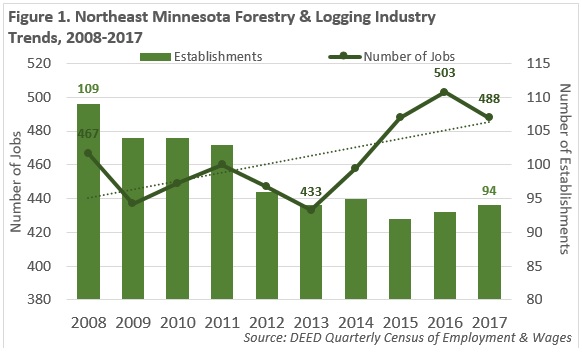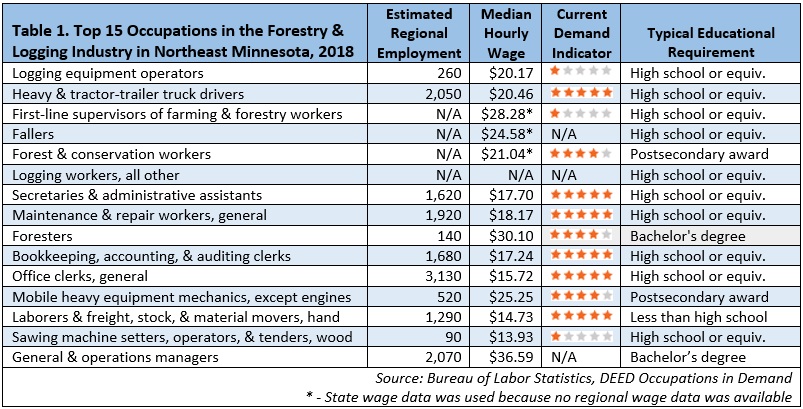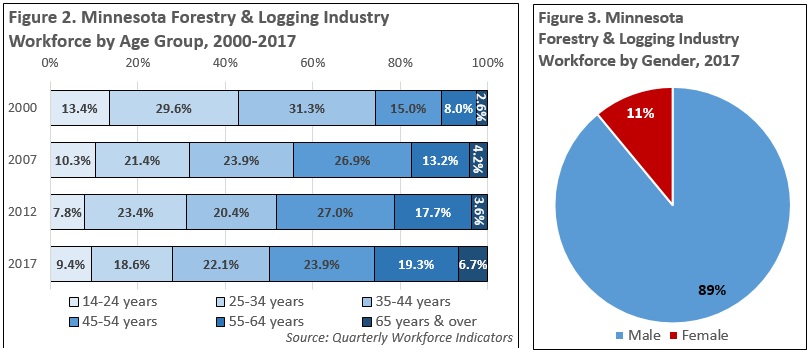 Home to the state's second-largest metro, the Northeast Region has a strong industrial sector, tied largely to the area's abundant natural resources.
Home to the state's second-largest metro, the Northeast Region has a strong industrial sector, tied largely to the area's abundant natural resources.
Most of the manufacturing base centers on mining and forest products industries. More than half of the sector's employment is in paper and machinery manufacturing.
Want the freshest data delivered by email? Subscribe to our regional newsletters.
12/6/2018 12:00:00 PM
Cameron Macht
According to job counts from DEED’s Quarterly Census of Employment & Wages program, the forestry and logging industry in Minnesota was made up of 211 establishments providing an average of just over 1,000 jobs in 2017. Home to most of the state’s forest land, it is not surprising that almost half of the state’s employment in forestry and logging is located in the seven-county Northeast Minnesota region.
Despite some fluctuations, forestry and logging industry employment is up 8.7 percent statewide since 2000, including a gain of nearly 100 net new jobs in the past 10 years, despite a decline in the number of firms. The industry has experienced similar trends in the Arrowhead, regaining 55 jobs since 2013, even while losing employer establishments. After briefly surpassing 500 jobs in 2016, the region is now home to 94 firms providing 488 jobs, with a total payroll of $21 million in 2017 (Figure 1).

Like other industries in the region, forestry and logging establishments are facing intense competition for workers, especially for heavy and tractor-trailer truck drivers, maintenance and repair workers, mobile heavy equipment mechanics, and laborers and freight movers, which are in high demand across several sectors. Likewise, office occupations – secretaries and administrative assistants, bookkeeping and accounting clerks, office clerks, general and operations managers – are also in high demand in industries across the Arrowhead.
Because they are smaller occupations with fewer jobs, there was less current demand for forestry-specific positions like logging equipment operators and sawing machine setters, while demand was higher for forest and conservation workers and foresters. The lack of workers overall makes every position harder to fill, with forestry and logging employers competing to attract workers that can be placed in a wide variety of other occupations and industries. Eleven of the top 15 jobs in the forestry and logging industry can be gained with a high school diploma or equivalent and some level of on-the-job training; two require vocational training; and two require a bachelor’s degree (Table 1).

High school graduates and other job seekers will be important in filling the workforce pipeline in the forestry and logging industry, which relies on a seasoned workforce. In 2017, data from the Quarterly Workforce Indicators program shows over one-fourth of workers in the industry were 55 years or older, up from just 10.6 percent of the workforce back in 2000. In contrast, less than 10 percent of workers in the industry were under 25 years of age, down from 13.4 percent in 2000 (Figure 2).

Further demographic data from the QWI program shows that the forestry and logging industry is relatively non-diverse: Males account for 89 percent of workers (Figure 3), and more than 97 percent reporting white as their race. Those percentages have remained virtually unchanged since 2000, with both shifting less than 1.5 percent despite much more rapid changes in the overall labor force. Forestry and logging employers may need to tap into new labor pools to attract talent and continue growing.
Contact Cameron Macht at 320-441-6596 or cameron.macht@state.mn.us.